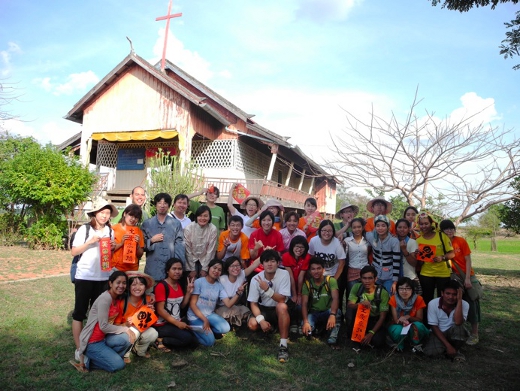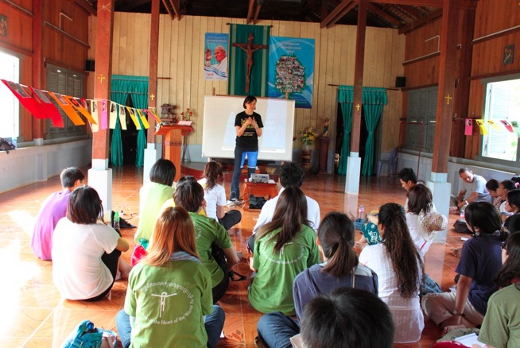Following MAGiS 2011 in Spain, a MAGiS Experiment was held in Cambodia with 27 young people from Hong Kong, Korea and Cambodia. It was held in the city of Kampong Thom, north of the capital Phnom Penh, from January 22 to 27. The theme of the experiment was “With Christ at the Heart of the World”.
 |
| At Kampong Ko Church, Kampong Thom. |
The young people – six from Hong Kong, 13 from Sogang University, Korea, and four university students from the Catholic Student Centre in Phnom Penh and four from the Apostolic Prefecture of Battambang – were hosted by MAGIS veteran Ms Phon Sonai from Kampong Thom and Fr Jub Phongphand SJ, parish priest of Kampong Thom.
There was a sharing of culture. The Cambodian group showed everyone how to use the traditional and multi-purpose kroma, while the participants from Hong Kong demonstrated how they celebrate Chinese New Year. The Korean students presented a slideshow that simulated a trip to Korea beginning at the airport with visits to popular destinations such as Jeju Island. One of them wore the traditional dress, hanbok.
 |
| Wendy talking about God’s desire for us. |
There were sub-themes for each day and these were outlined in short but substantial spiritual input sessions at the beginning of the day. During the daily input sessions, the young people shared who they were and their desires, as well as what they believed God’s desire for them was.
They also learned how acceptance of love leads to power and dynamism, about the need for reconciliation and about God’s invitation to mission. In addition, Fr Jub told them of the history of the Church in Cambodia.
 |
| Packing grain in sacks and appreciating the effort it takes to make the rice we eat. |
The group also helped to build houses for three villagers, planted trees near the church, and gathered, packed and stored rice grains.
A special feature of this year’s experiment was the pilgrimage. For two hours, they walked in prayerful silence at their own pace through the countryside to Kampong Ko Church. It was a fruitful experience and some even said that it was not long or far enough.
Regardless of when the day’s activities ended, they gathered each evening for group Examen and Magis Circle to reflect on and share with the others God’s movement in their lives that day.
As often happens in MAGiS, complete strangers ended up with close bonds by the close of the experiment. However, it is how they experienced God moving in their hearts during MAGiS that makes this activity worthwhile.


